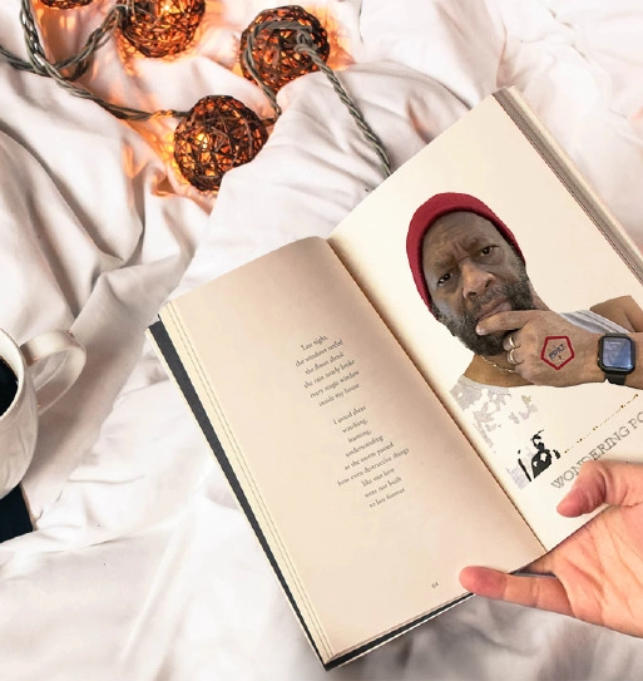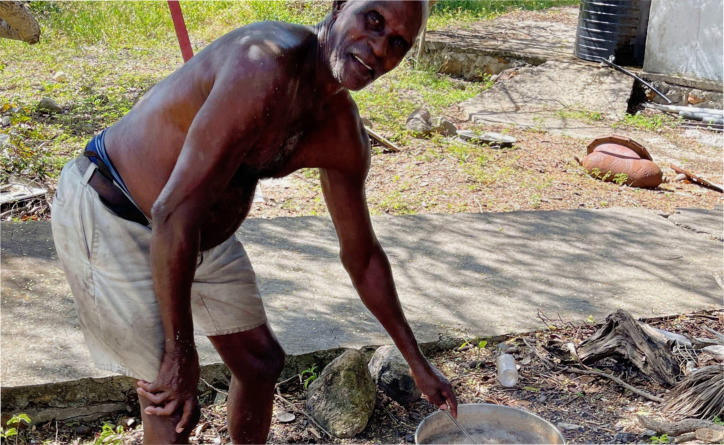







ACKNOWLEDGMENT :
I am the poet Kenvil Atkins Lewis, also an author, if you know my history you would not be amazed at my voyages from my infancy into the twilight of my years, this is a true extract of my sweet home Canelles, my parents left me when I was just a mere tot, I was carried here there and everywhere, but the greatest pleasure I have known was when I was placed in the custody of my grandmother who lived in canelles, that was a long time ago, this is my story as I remember it. HISTORY OF OLD CANELES. ( Saint Lucia ) Author: Kenvil Atkins Lewis The true history of a sleepy Hamlet called Canelles between the north lies a bridge, and lower down South lies another bridge, lonely Canelles falls right in the middle. An area as large as the eye could see, for you could not see much, green lush bushes to the North, that dwarf the secret below, a canopy of twigs from the ocean to grandma's door, she called it the Mang. Canelles is a steep hill, and at the top lies its only inhabitants two pioneering adventurous citizens, one Leslie we will call Mr. Leslie, and the other Safe, whom we will call Mr. Safe. Leslie was married he had fourteen siblings, while Safe was a bachelor, that is in the year of fifty-two. The two residents of Canelles live within half a yard of each other, farming their respective choice of dirt land, those two men were fishermen by trade. There were no shops to be found for miles around, no church or school, no hospital, no lamp post or roads, but there was a highway that led to the town of Vieux-Fort in the South and ran its course to Castries in the North. Now let us take a walk from the North bridge, momentarily stopping at Leslie and Safe, it’s a stiff climb from the North River till you reach the top, along the climb you can see what the two farmers cultivated Peagon peas, cassava, and sweet potato now and then a pawpaw tree, those were the vegetation grown below the highway till you reach the hilltop. At the top, the soil was much too hard to plant but was consumed with cashew nuts, guava, tamarind, a few mango trees, sour sop, and sugar apples, as you proceed at a decent the lovely ocean welcomes you to a lush tropic of twigs that run right into the sea. continue below
OOLD CANELLES
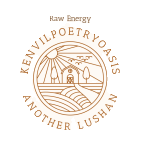


Chapter Two
THE TRUE HISTORY OF OLD CANELLES As told by eye witness of no other than Kenvil Atkins Lewis author / poet his life with his grandmother living in Canelles
WHO WOULD BE KING
Making a living was hard work indeed, in the little Hamlet of Canelles, even though the land was dry, it yielded other resources important enough to make some needed cash, wood was plenty, charcoals were manufactured regularly, parm leaves were plentiful and brooms were made from its dried leaves, other products that were made were ferine from the cassava collected, peas gumbo by the bundle, honey, molasses, cassava bread, fresh fish, cashew nuts, tamarin and much more. Nightlife in Canelles was an adventure, the fire torches made out of a special tree bark kept one from stumbling in the dark, high tide would bring up the fishes to the brink of the river, and many would be nestled in the grass near the edges, which made them an easy target to catch, there was also plenty of blue crabs just walking up to from their borrow trying to escape the salty water, which became an easy catch. WHO WOULD BE KING? The two pioneers Leslie and Safi were the only occupancy of the little Hamlet called Canelles, one would think that they would fight over kingship in this little Hamlet, but far from it those two men were as different as different could be, there was never a quarrel between them, there was equality harmony and togetherness, eventually Safi would woe Cecilia one of Leslie daughter, giving birth to two handsome boys, Herbert the oldest and Joseph, this two boys would grow up to find their niche right next to their parents. The two matrices went about their daily business, Leslie a fisherman by trade, would walk down the narrow path located behind his home, that leads directly to the bay at Pwindaykye, at the water's edge was his small continue below.
Visit Canelles
When in Saint Lucia visit little Canelles
HISTORY OF CANELLES CONTINUE
modest
fishing
boat,
he
would
carefully
pack
his
lunch
in
a
box
located
under
the
seat,
then
he
would
gather
the
hooks
check
the
baits,
his
fishing
net
which
he
made
out
of
nylon
strings
anchored
with
lead
balls.
One
more
check
in
the
box
that
housed
the
tackles
and
spare
parts,
his
lunch
bag,
and
a
change
of
shirt,
making
sure
everything
was
fine
before
rowing
into
the
bay.
When
he
was
on
dry
land
as
the
fishermen
would say, he tended to his animals, a small fence corral of several sheep and goats not necessarily pen together, large pigs the size of hogs, and one cow which he milked occasionally.
Grandfather’s
clothing
fishing
attire
was
much
to
behold,
wrapped
around
his
loins
was
simply
a
cloth
that
sheltered
his
private
parts
in
the
shape
of
an
infant
diaper,
all
the
fishermen
dressed
this
way
in
Grandfather’s time.
Certain
months
of
the
year
there
was
a
high
concentration
of
sardines,
they
swam
near
the
shoreline,
in
that
particular
month
if
the
day's
catch
was
merger,
the
sardines
made
up
for
revenue,
to
catch
those
little
fast-jumping fishes not bigger than two inches, the fishermen use the home-made nets with the led balls to anchor and trap the sardines inside it, sometimes a boat full of sardines was the days catch.
It
is
no
wonder
that
Grandfather's
diet
lunch
would
be
a
helping
of
those
roasted
sardines
or
some
other
pot
fish,
farina
made
out
of
the
cassava
plant,
the
tree
sprouts
under
the
ground
a
huge
root
like
yam,
which
is
harvested,
this
yam-type
root
would
be
scraped
with
an
old
spoon
until
its
white
as
snow,
then
it
would
be
ground
upon
a
large
home-made
grater
until
it
is
a
mere
powder,
this
powder
substance
would
be
filled
into
fine
netted
bags,
the
bags
are
set
on
boards,
the
bag
would
then
be
topped
with
other
boards,
the
top
boards
would
be
weight
down
with
heavy
stones,
therefore
extracting
the
juices
from
the
raw
powder
until dry or for three hours or more.
Removing
the
bag
from
under
the
boards
its
powdered
contents
would
be
dry,
which
makes
it
ready
to
be
cooked
in
an
iron
skillet. You can read more about Farina in my book later.
So
grandfather's
delicious
lunch
was
farina
topped
with
a
stew
of
pigeon
peas,
roasted
sardines
sautéed
in
coconut
oil,
hot
pepper sauce two slices of avocado, and a jug of fresh cow milk.
On
the
other
hand,
Safi
grows
to
produce
from
a
little
sport
he
inherited
next
to
the
river
bank,
a
very
rich
soil
that
produces
such
plants
as
plantain,
bananas,
yellow
and
white
yams,
sweet
potatoes,
cassava,
sugar
canes,
breadfruit,
and
a
whole
mess
of
other
plants,
one
would
say
he
was
the
richest
man
in
Cannels,
he
also
herd
cattle
such
as
cows,
horses,
sheep,
goats,
pigs,
yes
this
lucky man had it all.
continue below.
There is lots to see and do in the small
Hamlet Canelles sample the fine
wine brewed at Canelles, visit Charles Lewis & sons Wine brewed right here at Cannels.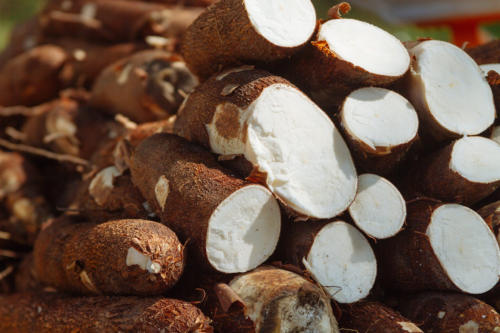


CHARLES LEWIS & SONS WINE
JUST LIKE CANELLES THE PLACE HAS EVOLVE Honestly living in Canelles was like living in paradise, the only teenagers present at the time were myself - Lambert - Herbert - and Joseph, the other children of Mr. Leslie were mostly grown folks. Author: Kenvil Atkins Lewis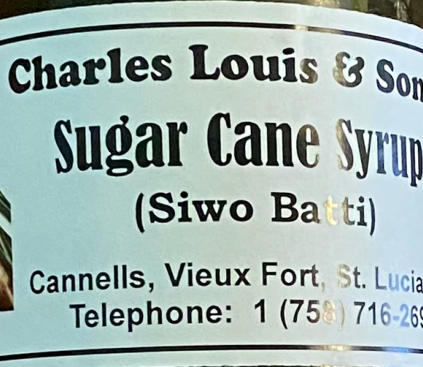

SAFI AN HONEST MAN
Safi lived in a modest home located right at the top of the Pwindaykye dirt track road, at the back of his house he raised herds of sheep, goats, donkeys, cows, and some chickens, the place was fenced all around so that the animals could not escape, he build a shed for the comfort of sheltering his animals from the rain, and to store bales of dry grass for the animals. The dirt track that leads to the river runs from behind the shed and down to the guava field until it reaches the bottom of the hill near the river’s edge, to get to the river on this side one has to pass near Safi's house, at the back of the house has a fence and a makeshift gate, you must go through before having access to proceed on the path that leads to the river below the hill, Safi had no problem with Leslie or his children using this track road to retrieve water from the river below. At the top of the track road the road parallel one went straight down, and the other pared to the right, the road to the right was barely bolder which formed a clearing that led to the bottom of the hill, at the bottom one would continue moving, straight forward into Safi farm or right to another track road, that would take you to the estuary, walking over the rocky cliff and down to the bay. Safi was a man with many talents, he did not do much fishing but he spent much of his time caring for the cattle that grazed near the honeymoon bay. To transport the feed from his home to the bay, Safi built big carts able to carry several bags of wheat with no effort at all, the road to the bay was an adventure in itself. Walking down the dirt road to the Bay of Honeymoon, a two-and-a-half mile distance, the first part of the road was well maintained until it came to a stop at a fenced with a large gate, the remaining road down to the bay was rough and covered with medium stones, tree roots and bushes, but due to the constant trafficking of the fishermen that commute this way it became manageable. GEOGRAPHY OF THE AREA In my assumption canelles was a very large place, judging from the distance of grandmother's house to the West lies a steep hill that runs two miles straight up, to the South behind grandmother's house one could only see dense bushes that lead down to the mange and into the sea, to the north the highway runs right next to grandmother door steps, forming a bend several hundred yards below, going pass Safi house and continue downwards to the river and beyond, to the East of grandmother house the land mass was huge roughly five miles down slop to a hidden beach well out of sight. Either way, you turn the area is void of houses nothing but bushes, on occasion a cashew nut tree, plenty of cedar trees, bushes, and more bushes till you reach the top of the beach, you can find lots of palm trees, lots of raisin trees. Grandmother took us on many trips to gather palm leaves there at the edge of the bay. THE ODD HOUSE OUT BACK to be continueSomeone must tell the story of old Canelles.
CRACKS IN THE ARMOUR
Powered by Wings for poetry oasis: mi7atkins@gmail.com 2023all rights reserves


